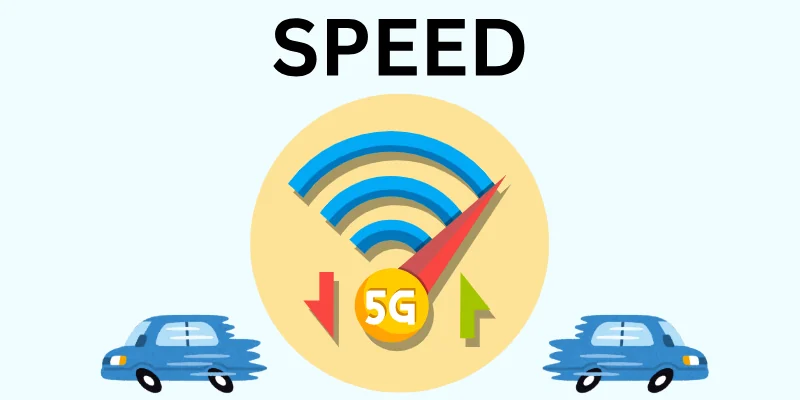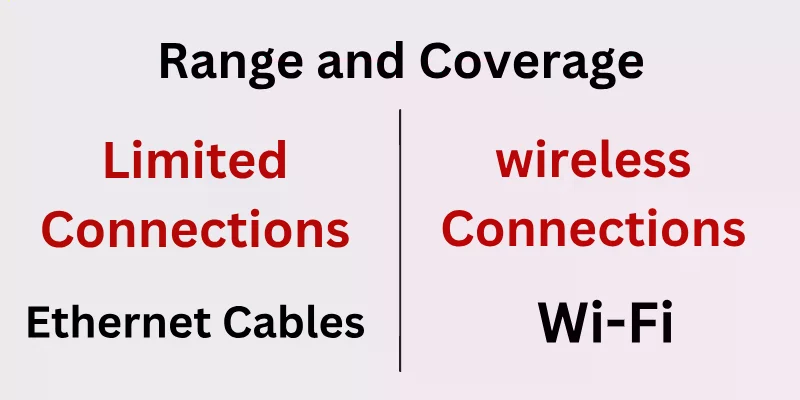Differences between Wired Ethernet and Wi-Fi
Published: 15 Oct 2024
In today’s connected world, choosing between wired Ethernet and Wi-Fi is a common consideration for users seeking reliable and suitable internet access. While both options serve the purpose of connecting devices to networks, they differ in terms of speed, reliability, security, and flexibility.

In this article, we will explore the key differences between wired Ethernet and Wi-Fi, highlighting their distinct features to help users make informed decisions based on their specific connectivity needs. For a deeper understanding of how internet communication works behind the scenes, you may also find our article on IPv4 vs IPv6 insightful, as it explains the evolution of IP addressing in modern networks.
Here is the list of Wired Ethernet vs Wi-Fi:
- Physical Connection
- Speed and Bandwidth
- Reliability
- Latency
- Range and Coverage
- Flexibility and Mobility
- Security
- Multiple Device Connectivity
- Installation and Setup
- Interference and Congestion
- Upgradability
- Cost
Let’s discuss Wired Ethernet vs Wi-Fi in details:
1. Physical Connection:
Wired Ethernet: Wired Ethernet involves the use of physical cables, typically Ethernet cables, to establish a direct connection between the device and the network router or modem.
Wi-Fi: Wi-Fi utilizes wireless signals to establish a connection between the device and the wireless router or access point.
2. Speed and Bandwidth:
Wired Ethernet: Wired Ethernet generally provides faster and more consistent speeds compared to Wi-Fi. Ethernet cables can support higher bandwidths, allowing for computer memory unit speeds and beyond.

Wi-Fi: Wi-Fi speeds are influenced by factors such as signal strength, interference, and distance from the router, which can result in reduced speeds.
3. Reliability:
Wired Ethernet: Ethernet connections are known for their reliability and stability. As a physical connection, Ethernet is less open to interference from other devices or environmental factors that can affect Wi-Fi signals.
Wi-Fi: Wi-Fi connections, while generally reliable, can experience fluctuations in performance due to interference from other wireless devices or block such as walls and furniture.
4. Latency:
Wired Ethernet: Latency in wired Ethernet refers to the delay experienced when data is transfer over a physical Ethernet cable. Similar to Wi-Fi, it is measured in milliseconds (ms) and represents the time taken for data to travel from one device to another through the wired network.
Key Factors Affecting Ethernet Latency:
- Network Congestion: While wired connections are less prone to congestion than Wi-Fi, excessive traffic on a wired network (from many users or large data transfers) can increase latency slightly.
- Propagation Delay: The time it takes for a signal to travel across the cable. It is usually very low because the speed of signal transmission in cables (almost the speed of light) is high.
- Switching and Routing: The time taken by network switches and routers to process and forward the data. High-end switches and routers typically have lower latencies.
- Device Processing Time: The time it takes for the sending and receiving devices (computers, servers) to process the data.
- Cable Length: Although Ethernet cables generally introduce minimal latency, longer cables can add a tiny amount of delay, though it’s usually negligible for most applications.
Wi-Fi: Latency in Wi-Fi refers to the time it takes for data to travel from the source to its destination over a wireless network. It is typically measured in milliseconds (ms) and represents the delay between when a request for data is made (like clicking on a link) and when the data starts to arrive.
Factors Affecting Wi-Fi Latency:
- Signal Strength: Poor signal strength increases latency as devices may need to resend data due to errors.
- Network Congestion: More devices connected to the Wi-Fi network can slow down response times.
- Interference: Physical obstructions, other wireless devices, and electronics can cause interference and increase latency.
- Router Quality: The hardware quality and configuration of the router can influence latency.
High latency can result in noticeable lag, especially in applications that need real-time interaction, like online gaming or video calls. Ideally, Wi-Fi networks aim for low latency to provide a smoother, more responsive experience.
Types of Latency:
- Network Latency: Delay caused by the transmission of data through routers, switches, and other network infrastructure.
- Propagation Latency: Delay based on the physical distance the data has to travel.
- Processing Latency: Delay caused by processing the data at both the sending and receiving devices.
Wired Ethernet vs. Wi-Fi Latency:
- Lower Latency: Wired Ethernet generally has lower latency than Wi-Fi because data transmission over cables is less susceptible to interference, signal strength issues, and blocking from other devices.
- Consistency: Ethernet provides more stable and consistent latency since it doesn’t suffer from the environmental and interference factors that can affect Wi-Fi.
Wired Ethernet is the preferred choice for applications requiring minimal latency, such as online gaming, live video streaming, or high-performance computing.
5. Range and Coverage:
Wired Ethernet: Ethernet connections are limited by the length of the Ethernet cables, which can range from a few feet to hundreds of feet with the use of additional network devices.

When it comes to wired connections, Ethernet is the gold standard for stability and speed. The only real limitation is cable length—typically anywhere from just a few feet to several hundred feet if you use additional networking equipment.
Wi-Fi: offers the convenience of wireless access, letting you connect from anywhere within range of your router or access point. But that freedom comes with trade-offs—signals can weaken over longer distances or when walls and other obstacles get in the way.
If you’re trying to decide which setup is best for your home or office, I break it all down in my full comparison here: Wired Router vs Wireless Router.
6. Flexibility and Mobility:
Wired Ethernet: Wired Ethernet connections are fixed and without moving, requiring devices to be physically connected to the network.
Wi-Fi: Wi-Fi offers greater flexibility and mobility, allowing devices to connect wirelessly from anywhere within the coverage area, ideal for laptops, smartphones, and other portable devices.
7. Security:
Wired Ethernet: Ethernet connections are generally considered more secure than Wi-Fi. Wired connections are difficult to hack unless physical access to the cables is obtained.

Wi-Fi: Wi-Fi signals, can be intercepted by unauthorized users within range, making encryption protocols (such as WPA2 or WPA3) trying to maintaining wireless security.
8. Multiple Device Connectivity:
Wired Ethernet: Ethernet connections typically require separate cables for each device, limiting the number of devices that can be connected directly to the network.
Wi-Fi: Wi-Fi, allows multiple devices to connect wirelessly to the network at the same time, making it more suitable for households or workplaces with many devices.
9. Installation and Setup:
Wired Ethernet: Ethernet connections require physical cable installation, which may involve drilling holes or running cables through walls, making it more complex and time-consuming.

Wi-Fi: Wi-Fi setup is generally simpler, requiring the configuration of wireless routers and the input of network credentials on devices.
10. Interference and Congestion:
Wired Ethernet: Ethernet connections are not open to interference or blocking caused by other wireless devices or neighboring networks.
Wi-Fi: Wi-Fi signals, can be affected by interference from other devices operating on the same frequency or by blocking Wi-Fi environments in packed populated areas.
11. Upgradability:
Wired Ethernet: Ethernet connections can be easily upgraded by replacing cables or network devices to support faster speeds or newer Ethernet standards.

Wi-Fi: Upgrading Wi-Fi involves replacing or upgrading wireless routers or access points to take advantage of newer Wi-Fi standards and technologies.
12. Cost:
Wired Ethernet: Ethernet cables and network devices are generally affordable, with one-time purchases providing long-term connectivity.
Wi-Fi: Wi-Fi routers or access points, while available at various price points, typically require periodic upgrades to keep up with evolving technology standards.
Conclusion:
Wired Ethernet and Wi-Fi each offer unique advantages and considerations when it comes to connectivity. Ethernet delivers faster speeds, higher reliability, and enhanced security, making it ideal for stationary devices or situations where consistent performance is critical.
Wi-Fi provides flexibility, mobility, and convenience, making it perfect for portable devices and environments with multiple connections.
Understanding the differences between wired Ethernet and Wi-Fi helps users choose the most appropriate option for their needs—whether at home, in the office, or on the go. If you’re also interested in how wireless technologies are evolving beyond Wi-Fi, take a look at my comparison of 4G vs 5G network technology.
FAQs about Wired Ethernet and Wi-Fi:
Here are some of the most FAQs related to Wired Ethernet vs Wi-Fi:
The main difference is in the connection method. Wired Ethernet uses physical cables to connect devices to a network, offering faster speeds and more reliable connections.
Wi-Fi is a wireless technology that allows devices to connect without cables but can be slower and more prone to interference.
Wired Ethernet is generally faster than Wi-Fi, offering more consistent speeds with less latency.
Wi-Fi speeds vary depending on the distance from the router, network congestion, and interference, while Ethernet provides a stable connection directly to the network.
Yes, Ethernet is more secure than Wi-Fi because it requires a physical connection to access the network, reducing the risk of unauthorized access.
Wi-Fi networks are more vulnerable to hacking or data interception, but strong encryption and security measures can help mitigate these risks.
Yes, Ethernet provides a more reliable connection because it isn’t affected by physical obstructions, interference, or distance like Wi-Fi.
This makes Ethernet better for tasks that require a stable connection, such as online gaming, video conferencing, or large file transfers.
Wi-Fi is more convenient for most users because it allows for wireless connectivity, offering mobility and flexibility without the need for cables.
Ethernet, while more stable and faster, requires physical connections, which can limit mobility and be less practical in certain environments.

- Be Respectful
- Stay Relevant
- Stay Positive
- True Feedback
- Encourage Discussion
- Avoid Spamming
- No Fake News
- Don't Copy-Paste
- No Personal Attacks

- Be Respectful
- Stay Relevant
- Stay Positive
- True Feedback
- Encourage Discussion
- Avoid Spamming
- No Fake News
- Don't Copy-Paste
- No Personal Attacks



